May is a great bass fishing month
I love fishing in May. I’m not going to say that it’s easy fishing, but it’s a month when you can catch bass on just about whatever lure you like or whatever way you like to fish the most. But you have to figure them out before you catch ‘em.
You can catch bass on topwater, especially early in the day. You can catch ‘em on little rock veins and riprap by throwing a Frittside 7 or a worm. And You can catch ‘em on shallow stumps you can see. You can catch ‘em anywhere.
The big secret is to cover a lot of water. Put your trolling motor down and stay on the move until you catch three or four fish, then try to refine the pattern you’ve established to focus on them even further. That’s when real fishing success begins.
Nothing covers water better than a crankbait or a topwater, maybe even a small Mojo rig, which is sort of a finesse version of a Carolina rig. I am going to carry a sack full of rods on my boat, with something different tied on every rod. It’s one of those deals where you fish whatever you have the most confidence in.
Most fish you’re going to catch in May – except maybe at the end of the month when the water has really warmed up – are going to be in 10 feet of water or less. A lot of them are going to be in 3 feet of water or less. Some of the best stringers I’ve ever caught came in May on a buzzbait, especially at Buggs Island and Lake Gaston. Woo Daves always fishes shallow stumps in May, and he’s won a lot of tournaments on Buggs Island. Understand, too, that shallow stumps are the same kind of structure as shallow docks and piers.
Take it to the bank
You probably aren’t going to have enough fish still bedding in May to really count on them. Some will be bedding, but not big numbers. And this is especially true on South Carolina lakes or in some of our eastern rivers. The spawns there are earlier, and those fish are going to be farther along. If you fish a lake with spotted bass, that will be a bonus, because spots are definitely going to have finished spawning. The very beginning of May might be tough if a lot of fish spawn late in April, because for a week or two, they’re sort of sickly and recovering. But by covering a lot of water, you can get past that. There are no rules for May. It’s whether you can find ‘em and what stage they’re in. Little gravel bars and gravel points, secondary points, are probably the No. 1 structure where you can find bass in May, because they do the same things coming out of the spawn as they do going in. Riprap is not far behind as a productive structure. They’re going to be around a rock, a bush or a stump. And they aren’t going to be out on the main lake yet. You need to figure out if they’re still in pockets or if they’re out on secondary points.
All that said, I’m going to have my boat in about 10 feet of water, throwing to the bank. All the fish are going to be between your boat and the bank. One thing to remember is that, this time of year, fish are going to be looking up. You still have some fish guarding fry, buck bass, that are looking up. And you’ll have fish that have recovered from the spawn looking up. Dragging a worm or banging a crankbait along the bottom might not work.
One thing I have a lot of confidence in throughout May is swimming a worm. I’ve really caught them good swimming a little paddletail or straight-tail worm. I used to fish something called a Seeker worm, which was a 6-inch worm with little wings on either side. I don’t think they make them anymore. But any straight-tail or paddletail worm will work. Berkley makes a super finesse worm, the Bottom Hopper, which is a worm with little or no action. Lately, with all the pressure on our lakes, a straight-tail worm will produce when a lot of others won’t. You want to be putting all the action in by twitching it – you don’t want any built in.
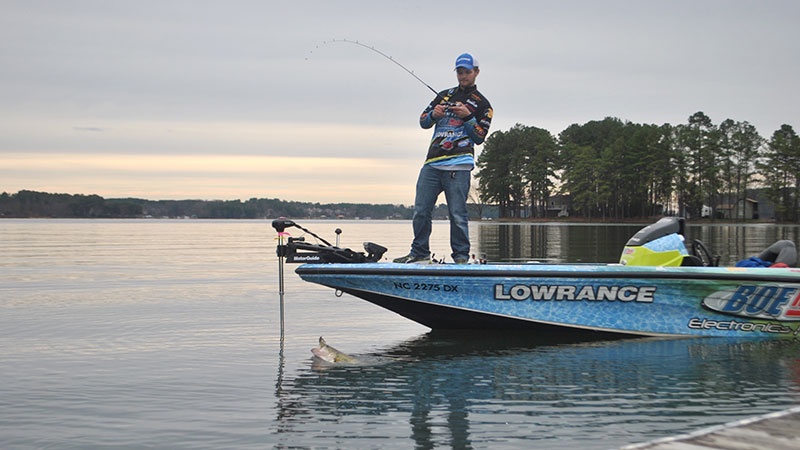
Go weedless
I rig the worm weedless and put a little 1/16- or ⅛-ounce worm weight on, either pegged or on a Mojo rig – with a light weight a few inches ahead of the hook. And I use 8-pound Trilene 100% fluorocarbon. I am going to cast that out at a target, and I’m going to wind it back real, real slow. A lot of times, if they’re not aggressive and biting a crankbait, they want something slow. By the end of May, fishing a crankbait or something like a ChatterBait-style bladed jig – a Slobber Knocker – can be deadly, but the little worm works until that happens.
Fishing a worm like this, I learned pretty quickly that casting up on the bank and winding the worm into the water and back to the boat worked a lot better. If I’m not fishing bushes, I try and make sure I cast up on the bank. I think if you cast in there into shallow water, and the worm makes a big splash when it hits the water, you won’t catch them as well. When I’m winding it back, I don’t want it on the bottom. I want to keep it about 2 feet off the bottom, because those fish are looking up. That’s why a little Frittside 5 or a buzzbait or a Slobber Knocker will catch them when it passes over their heads.
When I’m fishing in May, you probably aren’t going to find a lot of rods much longer than 7 feet on the deck of my Ranger. I’m target fishing – casting at bushes, stumps, dock pilings, rock veins when I can see them, and I like to fish a 6-foot-8 Lew’s baitcasting rod, because you’re more accurate with that shorter rod. Sometimes, if I can make a long pitch to a target, I’ll use a 6-foot-10 or a 7-foot-3.
Pay attention and you’ll be able to put together a productive pattern.The fish are looking up. Run a bait over their heads – and hold on.

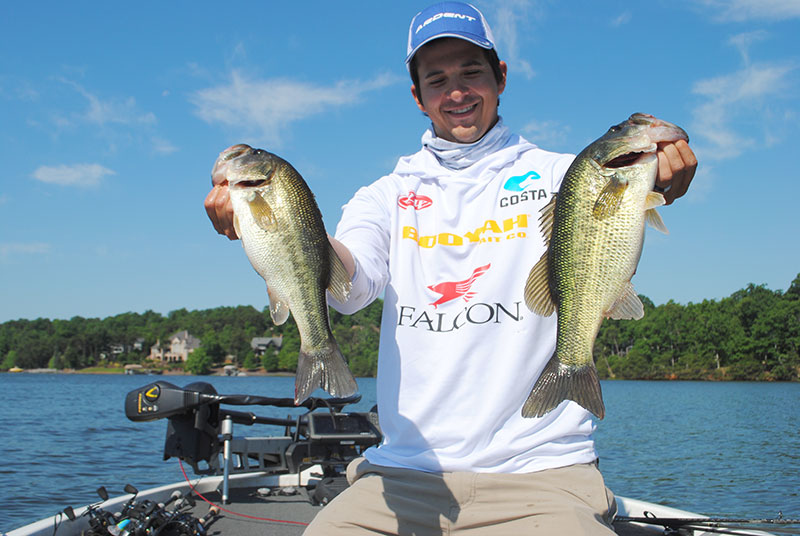
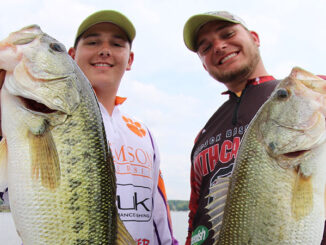
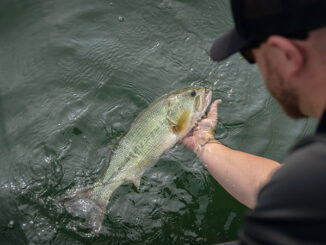
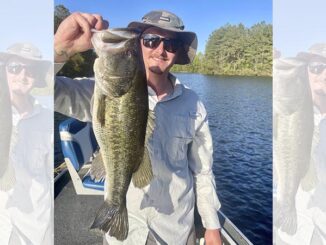

Be the first to comment